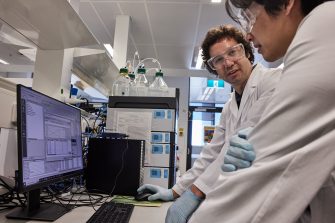Odour Laboratory
UNSW Odour Laboratory is the most advanced facility in Australia for emissions analysis.

Odour facilities
The odour laboratory has extensive analytical capacity for olfactory and chemical analysis of odours, odorants, and atmospheric contaminants. It also has specialist capability for undertaking field sampling from areas and point source emissions.
For a selection of our equipment and capabilities, please refer to the following application notes:

Emission sampling and storage
Emission collection
Prior to analysis of emissions, samples need to be collected from sources and transported to the laboratory.
Flux hood methods
Fluxhoods are a common method for collecting emissions from passive surface such as liquid surfaces (lagoons, settling ponds) and porous media (biosolids, soils). They use a consistent sweep flowrate of an inert gas (N2) to generate an emissions in a controlled setting, removing effects of concentration and equilibria associated with headspace or passive systems.
Wind tunnels are similar however use higher directionals sweep gas flowrates to simulate the effect of wind.
Gas storage and transportation
Gas sampling bags
A variety of materials can be used to prepare gas sampling bags, in the UNSW Odour Lab, Nalophan and Tedlar bags are predominantly used. However, the stability of certain samples should be initially tested to determine the effect of transportation or storage times on compound recovery.
Sorbent tubes
Sorbent tubes allow the preconcentration and storage of volatile compounds. A variety of sorbent materials including Tenax TA, Carbotrap are available in the laboratory. Emissions can be collected in-situ or from sampling bags using vacuum pumps. However, stability of compounds, size of target analytes and humidity of samples should be evaluated prior to use.
To find out more about these methods, get in touch with Odour@unsw.edu.au
Relevant publications
Liu L; Abdala Prata Junior A; Fisher RM; Stuetz RM, 2022, 'Measuring volatile emissions from biosolids: A critical review on sampling methods', Journal of Environmental Management, vol. 317, pp. 115290, http://dx.doi.org/10.1016/j.jenvman.2022.115290
Le H.V., Sivret E.C., Parcsi G., Stuetz R.M. (2015) Impact of storage conditions on the stability of volatile sulfur compounds in sampling bags. Journal of Environmental Quality 44, 1523 – 1529 https://doi.org/10.2134/jeq2014.12.0532

Olfactory-gas chromatography analysis
Olfactory-gas chromatography analysis
Odour detection ports have been coupled with a variety of analysis units to aid the identification of odour relevant compounds in complex mixtures.
The output of the gas chromatograph is split between the detector (usually MS) and the odour detection port (ODP).
The ODP provides humidified flows of the GC output which can be sniffed by trained pannelists. Panellists note the times at which specific odour events occur and provide a description of the odour and an intensity rating. This can be conducted at the press of a button using GERSTEL software and instrument set-up.
Applications
This technique has great potential in the identification of specific odorants in complex mixtures. Examples of its use include:
Identification of key odorants from industrial processes (biosolids processing, rubber processing) to inform odour management methods using Odour Wheels.
Identification of ‘unknown’ nuisance odorants that are challenging to identify analytically (e.g., nuisance or musty type odours from drinking water, or packaging contamination).
Confirming the efficacy of odour control devices.
To find out more about this technique, get in touch with Odour@unsw.edu.au
Relevant publications
Kamarulzaman NH; Le-Minh N; Fisher RM; Stuetz RM, 2019, 'Quantification of VOCs and the development of odour wheels for rubber processing', Science of the Total Environment, vol. 657, pp. 154 - 168, http://dx.doi.org/10.1016/j.scitotenv.2018.11.451
Fisher RM; Barczak RJ; Suffet IHM; Hayes JE; Stuetz RM, 2018, 'Framework for the use of odour wheels to manage odours throughout wastewater biosolids processing', Science of the Total Environment, vol. 634, pp. 214 - 223, http://dx.doi.org/10.1016/j.scitotenv.2018.03.352
Barczak RJ; Fisher RM; Wang X; Stuetz RM, 2018, 'Variations of odorous VOCs detected by different assessors via gas chromatography coupled with mass spectrometry and olfactory detection port (ODP) system', Water Science and Technology, vol. 77, pp. 759 - 765, http://dx.doi.org/10.2166/wst.2017.569

Siloxane analysis using Q-Tof (Targeted analysis)
Siloxane analysis using Q-Tof
The UNSW Odour Lab operates a variety of GC-MS systems that can be set-up for the targeted analysis of key analytes for different applications.
An example of which is the identification and quantification of siloxane type compounds, which are common problematic contaminants in biogas.
Applications
Based on industry requirements, a method was developed in-house for the accurate quantification of siloxanes in biogas produced from wastewater treatment plant anaerobic digesters and landfills.
Siloxanes are found in many consumer and laboratory products, and volatile components can become concentrated in biogas streams. When these compounds are combusted to recover energy, it can lead to increased maintenance due to silica deposition in equipment.
To find out more about these methods and potential applications, get in touch with Odour@unsw.edu.au

Sulfur Chemiluminescence Detectors
Sulphur Chemiluminescence Detectors
Volatile sulphur compounds are a cause of many nuisance odour impacts. Quantification of these odorants can be complicated by transformation and non-targeted analysis.
As such, the UNSW Odour Lab has a specific unit targeting 11 key common volatile sulphur compounds. Coupled with the use of specific gaseous sulphur standards, this allows for reliable quantification.
Sulphur chemiluminescence converts sulphur compounds in the GC eluant to sulphur dioxide, which can be detected by a photomultiplier.
The unit is also coupled with an NCD for the analysis of nitrogen-containing odorants. The unit allows for direct gas sampling using Markes AirServer and has a cold trap appropriate for sulphur compounds.
Applications
This technique is widely used for the targeted analysis of challenging organic volatile sulphur compounds, including mercaptans (methyl mercaptan, ethyl mercaptan) and sulphides (DMS, DMDS, DMTS). These are very common odorants in a variety of waste management industries (wastewater treatment, landfills, livestock).
This method has been used to determine baselines for process operation as well as odour control device effectiveness
To find out more about this technique, get in touch with Odour@unsw.edu.au
Relevant publications
Fisher RM; Le-Minh N; Alvarez-Gaitan JP; Moore SJ; Stuetz RM, 2018, 'Emissions of volatile sulfur compounds (VSCs) throughout wastewater biosolids processing', Science of the Total Environment, vol. 616-617, pp. 622 - 631, http://dx.doi.org/10.1016/j.scitotenv.2017.10.282
Wang B., Sivret E.C., Parcsi G., Stuetz R.M. 2015, Determination of VOSCs in sewer headspace air using TD-GC-SCD. Talanta 137, 71 – 79 https://doi.org/10.1016/j.talanta.2014.11.072

VOC analysis using TD-GC-MS
VOC analysis using TD-GC-MS
TD-GC-MS is used for identification and quantification of non-methane volatile organic compounds (NMVOC’s). Thermal desorption (TD) provides analyte pre-concentration; gas chromatography (GC) allow analyte separation; mass spectrometry (MS) provided analyte identification and quantification.
The UNSW Odour Lab operates a variety of these systems with varying capabilities for sample preparation (SPME, headspace, sorbent tubes) as well as mass spectroscopy set-ups (single tof, Q-tof, MS/MS).
When coupled with an Odour Detection Port (ODP) it can provide additional functionality of odorant identification and prioritisation within a gas phase sample. ( See Olfactory-gas chromatography analysis).
Applications
This method allows the identification and quantification of VOCs from complex mixtures from a variety of sources. Analyses can run as targeted (SIM) or non-targeted (SCAN) depending on study purposes.
VOC emissions from industrial processes, waste management systems, consumer products and packaging, food products, and ambient conditions, among others, have been analysed.
To find out more about these methods and potential applications, get in touch with Odour@unsw.edu.au
Relevant publications
Fisher RM; Le-Minh N; Sivret EC; Alvarez-Gaitan JP; Moore SJ; Stuetz RM, 2017, 'Distribution and sensorial relevance of volatile organic compounds emitted throughout wastewater biosolids processing', Science of the Total Environment, vol. 599-600, pp. 663 - 670, http://dx.doi.org/10.1016/j.scitotenv.2017.04.129
Sivret E.C., Wang B., Parcsi G., Stuetz R.M. 2016, Prioritisation of odorants emitted from sewers using odour activity values. Water Research 88, 308 – 321 https://doi.org/10.1016/j.watres.2015.10.020
Murphy K.R., Parcsi G., Stuetz R.M. 2014, Non-methane volatile organic compounds predict odor emitted from five tunnel ventilated broiler sheds. Chemosphere 95, 423 – 432 https://doi.org/10.1016/j.chemosphere.2013.09.076
To understand more about the Odour Laboratory capabilities, Odour facilities or for a quote regarding our services,
please email odour@unsw.edu.au
